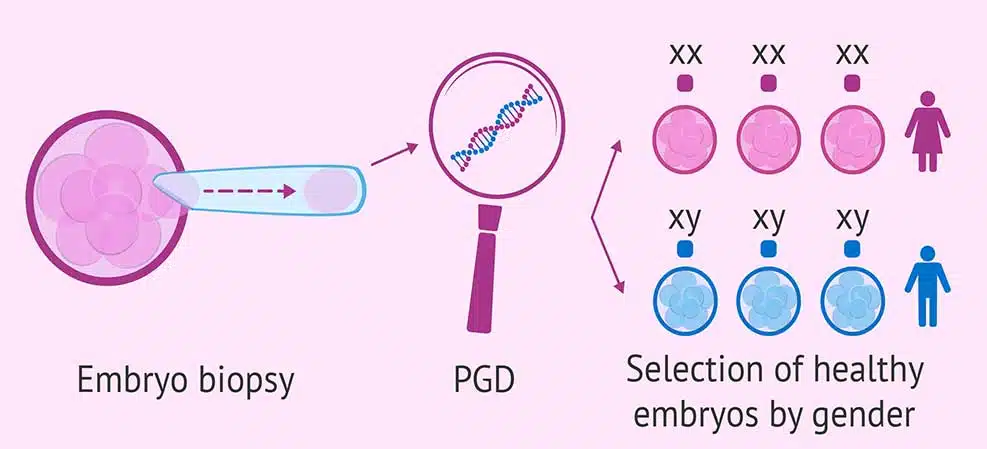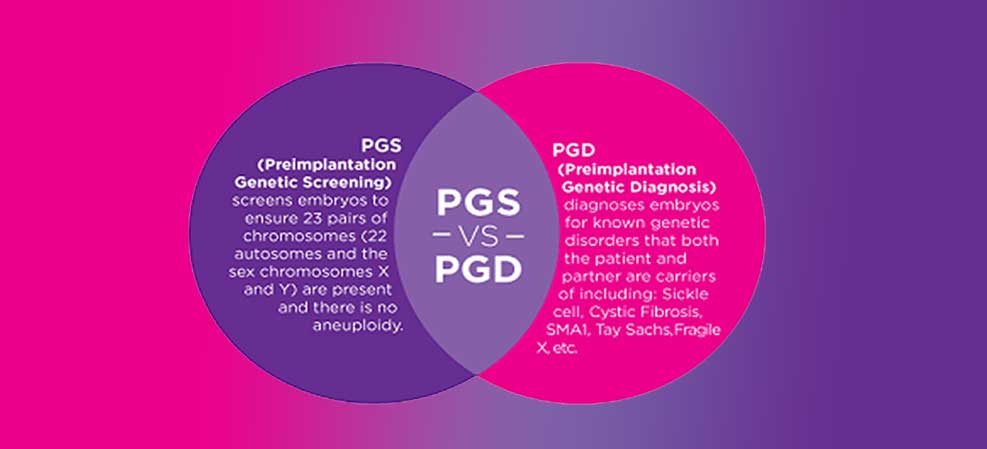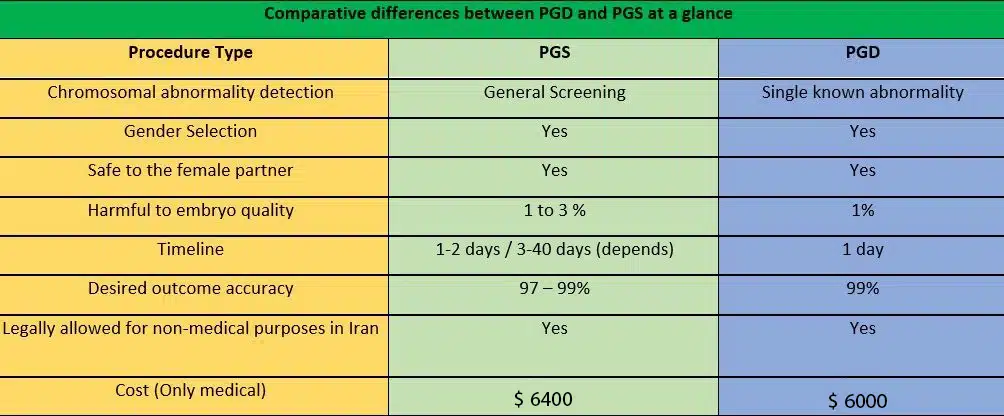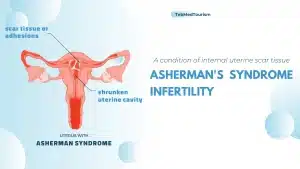Comparative difference between PGD and PGS at a glance
In summary, preimplantation genetic diagnosis (PGD) is dealing with a single already known genetic disorder and performing certain procedures on the embryo to detect the abnormality if available. However, preimplantation genetic screening (PGS) deals with the general state of health and well-being of chromosomes to identify any available abnormality and differentiate healthy chromosomes from unhealthy ones.
What is PGD?
Preimplantation Genetic Diagnosis (PGD) is a process of genetic testing that analyzes embryos to diagnose specific known hereditary disorders that have a high risk of passing on from parents to their children. PGD is prescribed for couples who are aware of their family history of inheriting a specific genetic abnormality and may have a genetic predisposition to pass on that abnormality to their children.
PGD testing is highly recommended for couples with a history of multiple miscarriages, birth defects, known chromosome abnormality, Trisomy 21 or Down syndrome, and Trisomy 18 known as Edward syndrome which occurs due to aneuploidy.
Moreover, couples who are aware of their genetic abnormalities, such as sickle cell anemia (sicklaemia), cystic fibrosis, Tay Sachs, fragle X, SMA1, and muscular dystrophy are highly recommended to undergo PGD testing before commencing IVF treatment. Fortunately, infertility centers in Iran perform gender selection which is included in the PGD package. Therefore, gender selection can be done via PGD testing in Iran and it’s included in the PGD treatment package.
To ease your decision-making and select the best option out of several possibilities, Teb Med Tourism is at your disposal to provide you with free consultation 24/7 on how to select the best option for your treatment to get desired results. Please book a free consultation appointment with us now (WhatsApp Number). Want to know more about the PGD process/cycle and IVF treatment in Iran?
Click here: IVF PGD in IRAN Difference between the cost of PGD testing in Iran and other countries Iran is considered one of the cheapest destinations with a higher success rate to undergo quality PGD testing compared to regional countries and beyond.
Currently, the Iranian currency (Rial) is facing the highest devaluation against international currencies particularly against the USD, which spotlighted Iran as the most reasonable and cheapest country for treating infertility. At the present, the cost of a complete cycle of PGD testing including pre-treatment consultations, IVF, gender selection (optional), related medical supplementary, and post-treatment consultations via TebMedTourism Company is $6000, which has attracted a considerable number of patients to seek treatment through our company. Non-medical packages are different and will be charged separately. We are happy that throughout our service career, we have served a significant number of patients from different countries to undergo PGD testing in Iran i.e. US, Canada, the UK, European Union, Afghanistan, Pakistan, Bangladesh, India, and Central Asia.

What is PGS?
Preimplantation Genetic Screening (PGS) testing is a genetic testing procedure that screens the general condition of an embryo to detect possible chromosomal abnormalities. Patients are more likely to perform PGS to ensure that their IVF treatment chance for a successful pregnancy is increased.
One of the main and unique difference between PGD and PGS testing is that, the PGS scope of testing and sphere of screening is wider and broader than the PGD and requires more time, energy, and money to get a quality result. Moreover, PGS is mostly performed by couples who are concerned about gender selection.
In addition, the PGS is also recommended for those female partners who are 38 and older, those who have experienced multiple miscarriages, or have a history of IVF failure. Difference between the cost of Preimplantation Genetic Screening (PGS) in Iran and other countries: As mentioned above, Iran is the most reasonable and cheapest destination to perform quality PGS testing, to get desired results with affordable and competitive prices compared to the regional countries and beyond.
Currently, the cost of a complete cycle of PGS testing including IVF and other medical supplementary via TebMedTourism facilitation is $6400, which is a competitive price compared to other destinations.
The success and accuracy rate of infertility treatment (PGS, PGD, and IVF treatment) facilitated via TebMedTourism has attracted an extensive number of patients from all around the world particularly the USA, Canada, Australia, European Union, Central Asia, Afghanistan, Pakistan and other South Asian countries to undergo these treatments via our company. PGS and PGD testing are time-consuming treatments and need prior planning and adequate consultations.
Therefore, Teb Med Tourism is here for you to facilitate your treatment planning and provide you with free consultation around the clock. Please book a free consultation appointment with us now (WhatsApp Number)
What is the difference between PGD and PGS?
Both PGD and PGS are embryo testing. PGD is a deeper analysis that goes beyond chromosomes to provide a genetic analysis before an embryo is transferred. PGD could checks recessive disorders like cystic fibrosis that might not manifest in the parents, but the embryos may carry the genes of the disease.
Also sex-related disorders about X or Y chromosome can be detected via PGD. In fact, PGD is a test for identifying embryos that are at high risk for inheriting a disorder.
PGS is not only to check the health and genetic conditions of the embryo. It can be a part of medical diagnosis to see what is the reason for infertility.If you’ve already suffered from multiple miscarriages, PGS may be able to shed light on the reasons why and helps to prevent it occurring again. PGS can address issues relating to infertility.
Difference between PGD and PGS desired outcome accuracy
One of the important issues that couples are concerned about is the PGD and PGS testing desired outcome and its accuracy. Fortunately, with the usage of high-tech methods in the course of PGS and PGD testing in Iran, the accuracy rate is amazing.
The infertility centers in Iran which are in partnership with Teb Med Tourism have recorded considerable accuracy rates. The accuracy rate for PGD predicted outcome is 99%, while the accuracy rate for PGS predicted outcome is between 97% to 99% depending on the general well-being of the chromosome and its genetic deficiency prevalence.
Difference between the impacts of PGD & PGS on the quality of embryos
Interferences to the general status quo and the nature of natural creation will affect its condition and may have consequences. Although Technological development in the field of infertility treatment has considerable pros, the cons are also noteworthy.
Fortunately, the preimplantation genetic diagnosis (PGD) process does not harm the overall condition of the embryo and can be considered a harmless process to the embryo. Nevertheless, preimplantation genetic screening (PGS) which performs a wider screening process of the embryo will affect its quality between 3 to 5 %, which will impact the overall pregnancy success rate to some extent.

Difference between PGD & PGS testing timeline
For medical tourists who are traveling from one country to another, time management is considered one of the main components that can be taken into consideration while planning their infertility treatment. The timeline for performing preimplantation genetic diagnosis (PGD) in Iran is only one day, while for preimplantation genetic screening (PGS) chromosomal evaluation the Iranian laboratories require 1 to 2 days to perform the PGS.
The most prominent difference between PGD and PGS is that performing a special genetic evaluation will take between 3 to 40 days in Iran depending on the general condition and genetic deficiency prevalence of the chromosomes.
While absolute certainty is hard to come by, still many different genetic conditions can be identified with PGS and PGD. You can also find out if the embryo being tested is viable for a successful pregnancy or not.
Although these tests recommend for all, you’re specially a good candidate If you already know that you or your partner have risk factors that may be passed onto your child.
Questions in this topic can be anxiety inducing. So don’t hesitate to ask any question of medical experts. If you have any questions about fertility services or testing, or you’re ready to get the process started, book an appointment online by TebMedTourism team to schedule a consultation today.
TebMedTourism team are always ready to answer you for free 24/7. Just contact us.











